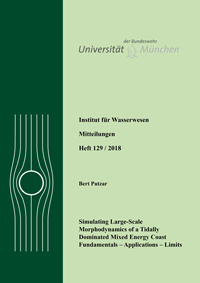
Shop : Details
Shop
Details
48,80 €ISBN 978-3-8440-6240-3Softcover194 pages46 figures517 g29,7 x 21 cmEnglishThesis
November 2018
Bert Putzar
Simulating Large-Scale Morphodynamics of a Tidally Dominated Mixed Energy Coast Fundamentals – Applications – Limits
In this thesis the natural large-scale sediment dynamics of a coastal domain with a tidally mixed energy coast is analysed. The German Bight, which is subject to complex morphology features and multi-scale sediment transport processes as well as extensive human impacts, serves as a real world test case. The numerical computations have been carried out with a coupled model that simulates shallow water flow, the sea state, fractionated transport of non-cohesive and cohesive sediments as well the resulting bed evolution.
Based on literature research, the sub-grid scale bed forms ripples and dunes are systematically included in the formulation of the underlying equations. Their height and length are predicted under current and wave conditions. Bed form dimensions serve as estimates for form roughness as well as for sediment transport computations. The bed roughness model considers the effect of grains, ripples, dunes and wave impact. As a result, the system of equations becomes highly non-linear and exhibits a very dynamic interaction.
The bed load part of the Exner equation is identified to cause problems for long-term morphodynamic simulations. To allow stable computations, the Residual-Distribution (RD) schemes are applied to the bed evolution equation. The Flux-Corrected method in combination with RD schemes shows an excellent performance for all the test cases. Furthermore, the effect of gravitational transport on the bed evolution is investigated systematically.
For the German Bight model a comprehensive calibration and validation strategy is presented in detail and applied with a convincing performance. The sediment dynamics of the German Bight is investigated with different scenarios considering the impact of tide forcing, wind and waves as well as the sea level rise. Basically it can be stated that the German Bight acts like a sediment trap. Suspended load is by far the dominating transport mode. Tide forcing only leads to lower transport rates than in combination with wind and waves.
In summary it can be stated that the presented results provide a comprehensive basis to enhance numerical coastal models. Especially the prediction of spatially and temporarily variable bed forms and the corresponding roughness improves the physical background, in contrast to fixed and user defined values. This can therefore increase the model skills in real world scenarios. Hence, such a numerical model system is a step forward for reliable morphodynamic predictions of complex large-scale coastal domains over decades to centuries.
Based on literature research, the sub-grid scale bed forms ripples and dunes are systematically included in the formulation of the underlying equations. Their height and length are predicted under current and wave conditions. Bed form dimensions serve as estimates for form roughness as well as for sediment transport computations. The bed roughness model considers the effect of grains, ripples, dunes and wave impact. As a result, the system of equations becomes highly non-linear and exhibits a very dynamic interaction.
The bed load part of the Exner equation is identified to cause problems for long-term morphodynamic simulations. To allow stable computations, the Residual-Distribution (RD) schemes are applied to the bed evolution equation. The Flux-Corrected method in combination with RD schemes shows an excellent performance for all the test cases. Furthermore, the effect of gravitational transport on the bed evolution is investigated systematically.
For the German Bight model a comprehensive calibration and validation strategy is presented in detail and applied with a convincing performance. The sediment dynamics of the German Bight is investigated with different scenarios considering the impact of tide forcing, wind and waves as well as the sea level rise. Basically it can be stated that the German Bight acts like a sediment trap. Suspended load is by far the dominating transport mode. Tide forcing only leads to lower transport rates than in combination with wind and waves.
In summary it can be stated that the presented results provide a comprehensive basis to enhance numerical coastal models. Especially the prediction of spatially and temporarily variable bed forms and the corresponding roughness improves the physical background, in contrast to fixed and user defined values. This can therefore increase the model skills in real world scenarios. Hence, such a numerical model system is a step forward for reliable morphodynamic predictions of complex large-scale coastal domains over decades to centuries.
Keywords: Küsteningenieurwesen; numerische Verfahren; Sedimenttransport; gekoppeltes Modellsystem; Telemac
Mitteilungen / Institut für Wasserwesen
Edited by Univ.-Prof. Dr.-Ing. Christian Schaum (Siedlungswasserwirtschaft und Abfalltechnik) and Univ.-Prof. Dr.-Ing. Andreas Malcherek (Hydromechanik und Wasserbau), München
Volume 2018,129
Available online documents for this title
You need Adobe Reader, to view these files. Here you will find a little help and information for downloading the PDF files.
Please note that the online documents cannot be printed or edited.
Please also see further information at: Help and Information.
Please also see further information at: Help and Information.
| Document |  | Document | ||
| Type |  | |||
| Costs |  | 36,60 € | ||
| Action |  | Purchase in obligation and download the file | ||
| Document |  | Table of contents | ||
| Type |  | |||
| Costs |  | free | ||
| Action |  | Download the file | ||
User settings for registered online customers (online documents)
You can change your address details here and access documents you have already ordered.
User
Not logged in
Export of bibliographic data
Shaker Verlag GmbH
Am Langen Graben 15a
52353 Düren
Germany
Am Langen Graben 15a
52353 Düren
Germany
Mon. - Thurs. 8:00 a.m. to 4:00 p.m.
Fri. 8:00 a.m. to 3:00 p.m.
Fri. 8:00 a.m. to 3:00 p.m.
Contact us. We will be happy to help you.



